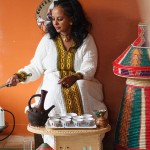The staple food of choice for most Ethiopians (except for those that live in the far south and west) is “Injera”, a large, porous and circular flat bread, produced by fermenting the nutritious local grain “Teff”, which is highly rich in complex carbohydrates and proteins, and baking it in a special wood or electric stove (Mitad) used exclusively for this purpose.
Injera, which is served with accompanying stews or curries known as “Wot”, is eaten using only one’s hands so try and refrain the urge to tackle it with cutlery in public places since that might invite stares or even friendly reproach from locals. The traditional way to eat Injera is by cutting off a piece from the edge of the plate using your fingers and scooping up a proportional amount of Wot or any other placed in its midst. Do not be surprised if you or someone around you is offered a “Gursha” which is a customary sign of respect and kinship accomplished by hand-feeding someone else (usually a family member or honored guest) with a single morsel of Injera and Wot.
There are generally two classifications of Wot, namely AlichaWot and Kay Wot. Most foreigners prefer the milder flavored and yellow coloredAlicha, since it is easier on the tender palate than the spicy, pepper infused Kay (red in Amharic) Wot. The official national dish of Ethiopia (and arguably the best) is Doro (chicken) Wot, a favorite of many, consisting of delicately stewed limbs of chicken in Kay Wot. There are also Siga (meat) Wots which can be either beef or mutton according to your preference.
On fasting seasons or days (Wednesday and Friday), Orthodox Christian Ethiopians favor vegetarian dishes or Wots, in fact the faithful avoid all animal products (with the exception of fish) on Lent as well. Most restaurants offer the vegan dish “Beyaynetu” on fasting and non-fasting days. Beyaynetu is Amharic for “mixture” and as the name implies it is a combination of several bean and lentil based Wots (Shiro for bean puree and Misir for lentil) plus cabbages, salads and other vegetable dishes served on one large plate of Injera from which several people may eat all at once.
Ethiopian breads also have distinct tastes. One type of traditional bread baked for the holidays is difodabo. It is baked in a clay oven over a manure fire with the dough wrapped in false banana leaves. The smaller sized mulmul, which is baked during the Buhe Festival, also has an amazing taste. The thick pita-like kita or the thicker ambasha graces holidays and birthdays. Nowadays, ambasha and difo are available in many supermarkets. Dabokolo is made from roasted pellets of wheat dough mixed with a little sugar, oil, and some food coloring but no yeast. Crunchy and delicious, it is also available in most supermarkets.



